Mikeson stuvia
One-Stop-Shop For The Latest Proctored Exams, ATI, HESI, NCLEX, TEAS, OCR, AQA, I-Human, Test Banks, Essays, Lecture Notes, Books, Study Guides, & Other Academic Prerequisites On Any Subject. Get the best study guides with verified solutions. I only offer the best documents with an approval rate exceeding 95%.
- 178
- 0
- 0
Community
- Followers
- Following
178 items
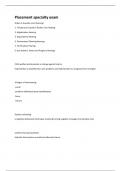
Placement specialty exam
Order of Juvenile court hearings 1. Temporary Custody / Shelter Care Heating 2. Adjudication Hearing 3. Dispositional Hearing 4. Permanency Planning hearings 5. Termination Hearing 6. but anytime. Status and Progress Hearings Child welfare professionals as change agents help to help families to identify their own problems and help families to recognize their strengths 4 Stages of Interviewing -social -problem definition/needs identification -focus -closure
- Exam (elaborations)
- • 14 pages •
Order of Juvenile court hearings 1. Temporary Custody / Shelter Care Heating 2. Adjudication Hearing 3. Dispositional Hearing 4. Permanency Planning hearings 5. Termination Hearing 6. but anytime. Status and Progress Hearings Child welfare professionals as change agents help to help families to identify their own problems and help families to recognize their strengths 4 Stages of Interviewing -social -problem definition/needs identification -focus -closure

perioperative nursing nclex questions
____ 1. The preoperative phase encompasses which period of time? 1) Entry to the operating suite until admission to post anesthesia care 2) Entry into the operating suite until discharge from the hospital 3) The decision to have surgery until admission to post anesthesia care 4) The decision to have surgery until entry to the operating suite 4 ____ 2. A 2-year-old child is scheduled for a tonsillectomy. When determining the plan of care, the nurse should: 1) Include the parents or c...
- Exam (elaborations)
- • 18 pages •
____ 1. The preoperative phase encompasses which period of time? 1) Entry to the operating suite until admission to post anesthesia care 2) Entry into the operating suite until discharge from the hospital 3) The decision to have surgery until admission to post anesthesia care 4) The decision to have surgery until entry to the operating suite 4 ____ 2. A 2-year-old child is scheduled for a tonsillectomy. When determining the plan of care, the nurse should: 1) Include the parents or c...
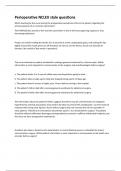
Perioperative NCLEX style questions
Which teaching by the nurse during the preoperative period best informs the patient regarding the primary purpose of an incentive spirometer? The PURPOSE (key word!) of the incentive spirometer is that it will encourage lung expansion, thus decreasing atelectasis. Proper use entails holding the breath 3 to 5 seconds at a time, setting daily goals, and sealing the lips tightly around the mouth piece are all directions on how to use the device, but do not describe its function. (be careful o...
- Exam (elaborations)
- • 27 pages •
Which teaching by the nurse during the preoperative period best informs the patient regarding the primary purpose of an incentive spirometer? The PURPOSE (key word!) of the incentive spirometer is that it will encourage lung expansion, thus decreasing atelectasis. Proper use entails holding the breath 3 to 5 seconds at a time, setting daily goals, and sealing the lips tightly around the mouth piece are all directions on how to use the device, but do not describe its function. (be careful o...
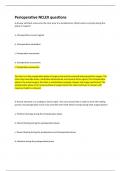
Perioperative NCLEX questions
A 26-year old client comes into the clinic prior to a tonsillectomy. Which action is priority during this phase of surgery? a. Intraoperative consent signed b. Intraoperative medication c. Preoperative assessment d. Postoperative assessment c. Preoperative assessment The client is in the preoperative phase of surgery and must be assessed and prepared for surgery. The client may have labs drawn, medication administered, and consent forms signed. The intraoperative phase is the actual sur...
- Exam (elaborations)
- • 10 pages •
A 26-year old client comes into the clinic prior to a tonsillectomy. Which action is priority during this phase of surgery? a. Intraoperative consent signed b. Intraoperative medication c. Preoperative assessment d. Postoperative assessment c. Preoperative assessment The client is in the preoperative phase of surgery and must be assessed and prepared for surgery. The client may have labs drawn, medication administered, and consent forms signed. The intraoperative phase is the actual sur...
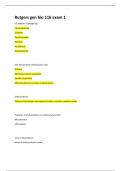
Rutgers gen bio 116 exam 1
6 Eukaryotic Supergroups Chromalveolata Excavate Opisthosomata Rhizobia Amoebozoa Archaeplastida Key derived traits of Eukaryotic Cells Nucleus Membrane-bound organelles Aerobic respiration Mitochondria from primary endosymbiosis Endosymbiosis Relationship between two species in which one lives inside the other
- Exam (elaborations)
- • 19 pages •
6 Eukaryotic Supergroups Chromalveolata Excavate Opisthosomata Rhizobia Amoebozoa Archaeplastida Key derived traits of Eukaryotic Cells Nucleus Membrane-bound organelles Aerobic respiration Mitochondria from primary endosymbiosis Endosymbiosis Relationship between two species in which one lives inside the other

Perioperative Care NCLEX Questions - MED SURG FINAL
A patient is to have a left inguinal hernia repair at the outpatient surgical clinic. Preoperatively, it is most important for the nurse to determine whether the a. patient has had any experience with outpatient surgery in the past. b. patient's medical plan covers outpatient surgery. c. patient plans to stay overnight at the surgical center. d. patient has someone available for transportation and care at home. D
- Exam (elaborations)
- • 28 pages •
A patient is to have a left inguinal hernia repair at the outpatient surgical clinic. Preoperatively, it is most important for the nurse to determine whether the a. patient has had any experience with outpatient surgery in the past. b. patient's medical plan covers outpatient surgery. c. patient plans to stay overnight at the surgical center. d. patient has someone available for transportation and care at home. D
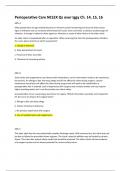
Perioperative Care NCLEX Qs over Iggy Ch. 14, 15, 16
ANS: A Older people have an age-related decrease in immune system functioning and may not show classic signs of infection such as increased white blood cell count, fever and chills, or obvious localized signs of infection. A change in behavior often signals an infection or onset of other illness in the older client. An older client is hospitalized after an operation. When assessing the client for postoperative infection, the nurse places priority on which assessment? a. Change in behavior ...
- Exam (elaborations)
- • 28 pages •
ANS: A Older people have an age-related decrease in immune system functioning and may not show classic signs of infection such as increased white blood cell count, fever and chills, or obvious localized signs of infection. A change in behavior often signals an infection or onset of other illness in the older client. An older client is hospitalized after an operation. When assessing the client for postoperative infection, the nurse places priority on which assessment? a. Change in behavior ...
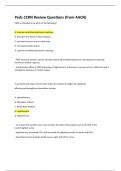
Peds CCRN Review Questions (from AACN)
PEEP is intended to do which of the following? A. Improve ventilation/perfusion matching B. Decrease functional residual capacity C. Increased venous return to the heart D. Increased cardiac output A. Improve ventilation/perfusion matching - PEEP increases alveolar volume, thereby improving ventilation/perfusion matching and increasing functional residual capacity. - A detrimental effect of PEEP (especially at high levels) is a decrease in venous return to the heart and a subsequent dec...
- Exam (elaborations)
- • 57 pages •
PEEP is intended to do which of the following? A. Improve ventilation/perfusion matching B. Decrease functional residual capacity C. Increased venous return to the heart D. Increased cardiac output A. Improve ventilation/perfusion matching - PEEP increases alveolar volume, thereby improving ventilation/perfusion matching and increasing functional residual capacity. - A detrimental effect of PEEP (especially at high levels) is a decrease in venous return to the heart and a subsequent dec...

Pathophysiology Exam 1 Practice Problems
A patient is found to have liver disease, resulting in the removal of a lobe of his liver. Adaptation to the reduced size of the liver leads to ___________ of the remaining liver cells. A. Metaplasia B. Organ atrophy C. Compensatory hyperplasia D. Physiologic hyperplasia C An older adult patient comes to the clinic complaining of not being able to do what he used to be able to. You know that normal changes associated with aging include: (Select all that apply.) A. Improved blood flow B...
- Exam (elaborations)
- • 33 pages •
A patient is found to have liver disease, resulting in the removal of a lobe of his liver. Adaptation to the reduced size of the liver leads to ___________ of the remaining liver cells. A. Metaplasia B. Organ atrophy C. Compensatory hyperplasia D. Physiologic hyperplasia C An older adult patient comes to the clinic complaining of not being able to do what he used to be able to. You know that normal changes associated with aging include: (Select all that apply.) A. Improved blood flow B...

PATHO KIDNEY STONE QUIZLET
Calcium stones Formed due to an excess mineral called OXALATE =- commonly found in some fruit, vegetables, nuts, and chocolate Struvite stones Less common and caused by an INFECTION in the urinary tract. It can grow quickly and become quite large Uric acid stones form due to CHRONIC DEHYDRATION. The risk increases in those with GOUT, a genetic tendency, or a diet too high in protein
- Exam (elaborations)
- • 2 pages •
Calcium stones Formed due to an excess mineral called OXALATE =- commonly found in some fruit, vegetables, nuts, and chocolate Struvite stones Less common and caused by an INFECTION in the urinary tract. It can grow quickly and become quite large Uric acid stones form due to CHRONIC DEHYDRATION. The risk increases in those with GOUT, a genetic tendency, or a diet too high in protein
